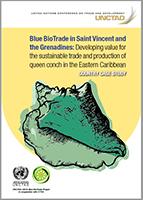
Saint Vincent and the Grenadines is a multi-island state comprised of the mainland (Saint Vincent) and seven inhabited islands of the Grenadines: Bequia, Mustique, Union Island, Canouan, Petit Saint Vincent, Palm Island and Mayreau.
As an archipelagic state in the Caribbean, with an exclusive economic zone 79 times larger than its land area, the economy of Saint Vincent and the Grenadines has strong connections to and reliance on ocean products and industries.
The queen conch fishery is currently one of the most important fisheries in the country, accounting for 62.7 per cent of total fisheries exports in 2020 and generating $3,329,937 (EC$8,990,832).
This case study presents a value chain analysis of queen conch production in Saint Vincent and the Grenadines.
It builds on a 2021 stakeholder map of the queen conch value chain of Grenada, Saint Lucia and Saint Vincent and the Grenadines. It is the last of three country case studies to be produced under the Blue BioTrade Project.
These case studies will contribute to the development of a regional Blue BioTrade Action Plan at a regional workshop to be held in mid-2022.
This report is divided into eight chapters.
Chapter 1 provides an introduction and overview of the approach taken by the case study.
Chapter 2 provides a product assessment, looking at the biology and location of the Saint Vincent and the Grenadines queen conch stock.
Chapter 3 analyses the regulatory, management and institutional frameworks in Saint Vincent and the Grenadines as they relate to the queen conch fishery.
Chapter 4 analyses the value chain, examining its economic features during the pre-harvest, harvest, and post-harvest stages.
Chapter 5 presents an initial assessment of current market access and potential entry points to a number of potential markets for queen conch products.
Chapter 6 outlines the main challenges faced by the value chain.
Chapter 7 outlines opportunities to sustainably address these challenges using the BioTrade P&C as a guideline.
Chapter 8 presents the recommendations and conclusions.
This country case study is produced under the UNCTAD and the Organisation of Eastern Caribbean States (OECS) project entitled, “Seizing the trade and business potential of Blue BioTrade products for promoting sustainable livelihoods and conservation of marine biodiversity in selected Organisation of Eastern Caribbean States countries” (Blue BioTrade Project).
The Blue BioTrade Project is implemented in cooperation with the Secretariat of the Convention on International Trade in Endangered Species of Wild Fauna and Flora (CITES) and is funded by the OECS and the European Union under the Regional Integration through Growth Harmonisation and Technology (RIGHT) project.


